. Legends about Hidarugami .
:::::::::::::::::::::::::::::::::::::::::::::::::::::::::::::::::::::::::::::::::::::::::::::::::::::::::::::::::::::::::::
道祖神 Doosojin (Doososhin, Dosojin Dososhin)
kido no kami 岐戸大神 see below
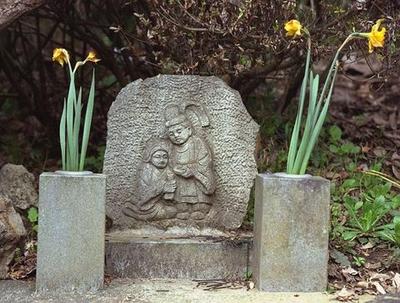
© Photo Gabi Greve
The Wayside Gods, Crossroads Gods, Corner Gods, Road Gods
I even found a connection to my Daruma and to Haiku, see below.
The origin of these wayside deities might go back to old Japanese Shintoo beliefs.
Chimatagami 岐神, the Gods of the Crossroads, is said to represent the legendary gods of Old Japan, especially
Sarutahiko no Mikoto 猿田彦神 and his fair maiden,
Ame no Uzume no Mikoto 天鈿女.
They are usually two stone figures, man and woman (wagoozoo和合像, sootai doosojin 双体道祖神) holding hands or his arm around her shoulder. Some are shaking hands, (akushu doosojin 握手道祖神).
Other couples are exchanging a coup of sake (shuugizoo 祝儀像). Usually he holds the small cup and she poors for him. Or he holds a ladle and she holds a fan (杓扇).
Sometimes they even embrace (hooyoozoo 抱擁像, in form of the Kankiten Deity, Kankiten gata 歓喜天形). Very seldom there is a child with the figures of grown-ups.
Since these stone markers are usually unprotected at the roadsides, wind and rain take their toll and the figures are quite washed out sometimes, giving them a special charm to the passer-by.
The stone markers sometimes carry an inscription (meibun 銘文), using the following Chinese characters and their equivalents with similar pronunciation:
way, ancestor, six, cold, fork in the road
doo 道、so 祖, roku 六、陸、禄, sai 才、寒、幸 or chimata 岐, 衢.
Most of these stone deities are found along the roads of Central Japan, especially Nagano and Yamanashi, but of course also in other parts. They are called by many names, for example: 賽の神 sai no kami, 障の神, 祖神 sae no kami, see no kami せーの神, sakai no kami 境神> sai no kami; 障神 shooshin; 衢神 kushin, 八衢神 yachimata no kami, 道俣神 chimata no kami;
doorokujin 道六神, / 道碌神 / 道陸神 Doroku-Jin (in connection with the six Jizo statues on the crossroads and the six realms of existence (rokudoo 六道),
岐神 chimatagami, ya chimatagami, 船戸神 funado no kami; 道の神 michi no kami, ひだる神 hidarugami、アラハバキ神 and more.
SAI or SAE means keeping out, destructing the way for the evil spirits.
They protect the traveller and all living beings on the road, they protect the borders of the village, prevent evil from entering and also protect the children of the village. Since they usually show a couple, they are of course also the protector deities of the family, of man and wife united in marriage and fertility.
Festivals in their honour are the fire festivities on the old lunar New Year, Dondoyaki どんど焼、sagichoo 左義長, saitoyaki 賽燈燒, 紫灯、寒灯. During these fire festivals around the 14 and 15 of January, the New Year decorations are burned, for example the ritual ropes, Shimenawa .
. dondon yaki どんどん焼き Dondo Fire Ritual .
Dooso 道祖 is also read as SAITO, therefore the burning of things during the New Year celebrations takes place in areas of reverence of the Wayside Gods. One of these famous rituals takes place in Ooiso, Kanagawa Pref. and is called Saitoyaki さいと焼き or Sankuroo Yaki 三九郎焼き. For more details see below.
Stone markers with only an inscription of 道祖神 are called "Doosojintoo" 道祖神塔。

http://kugenuma.sakura.ne.jp/sekizou.html
道祖神文字塔
. Sai no Kami 幸の神 God of Good Fortune .
- - - - - Sae no kami 障の神 - 塞の神
. shichinin misaki 七人ミサキ "Misaki of seven people" .
In Kochi, Tosa
Someone getting lost in the mountains is ユキアイ "meeting a deity", the malicious Doorokujin 道碌神 Doroku-Jin.. When they come back, they must stand at the entrance and be fanned by a willow and paste an amulet at the entrance.
.......................................................................
Hidarugami ヒダル神
. Legends about Hidarugami .

- quote
What Does Hidarugami Mean?
Hidarugami is written with the katakanaヒダル (hidaru) + the kanji 神 (kami; god). Things written in katakana have no inherent meaning. However, the word “hidaru” is most likely connected with 饑い (hidarui), meaning hunger. Hidarui is a colloquial term, used mainly in Gifu prefecture. Hidarugami is also sometimes written ひだる神 using the hiragana for “hidaru,” also with no inherent meaning.
The fact that the kanji “kami” is used places the hidarugami on a higher level than most yokai, alongside such devastating deities like the Binbogami (貧乏神; God of Poverty) and Shinigami (死神; God of Death). This elevated status is due in part to arising from human spirits, from reikon.
There are other names for the Hidarutami. In Kitakyushu, it is known as the Darashi (ダラシ), in Mie and Wakayama prefectures it is sometimes called the Dari (ダリ), while in Nara and Tokushima prefectures it is called Daru (ダル). All of these use katakana for the names.
The Hunger Strike of the Hidarugami
Are the Hidarugami Yokai or Yurei?
Hidarugami defy simple classification, and show the complicated nature of Japanese folklore. Are they yurei? Are they yokai? Are they Gods? Yes to all three questions. (And yes, it is a trick question as all yurei are yokai. Smart catch there!)
Hidarugami Across Japan
- source : hyakumonogatari.com
- quote
Hidarugami for example is the ghost of someone who died alone in the moors or mountains. This ghost possesses people making them so hungry they faint. To restore them a person must be given mochi.
More Folk Beliefs
Folk Religions are based on the idea of building a relationship with the spirit world, and are understood through folk tales and so often much stranger than more structured religions. With that in mind it's important to keep in mind that Shintoism and folk religion in Japan aren't always one and the same.
Folk Religions are based on the idea of building a relationship with the spirit world, and are understood through folk tales and so often much stranger than more structured religions. With that in mind it's important to keep in mind that Shintoism and folk religion in Japan aren't always one and the same.
A man in Tono had a beautiful daughter who married a horse, and she would sneak out to the stable to be with him. When the father learned of this he was furious and he had the horse killed and hung from a mulberry tree.
His daughter went out the tree and climbed onto the horses head. Disgusted the man cut off the horses head and the girl and the head flew off into the sky. She then became a kami named Oshira-sama who is now a kami of agriculture and silkworms. (Silk worm production was done in mulberry trees.)
Love has a certain amount of power to cause both good and bad. A young girl from a wealthy family fell in love with a temple page while out cherry blossom viewing. She sickened and pined for the young man, in order to comfort her, her mother bought a long-sleeved robe of the same pattern the page had worn; but though the daughter kept it by her and would not let it out of her sight, she grew no better and eventually died.
The family offered the clothing they’d given her to the temple, and ayoung girl bought it a few months later; soon after she pined away and died as well.
Again the dress was donated back to the temple and the priests sold it, again the girl who purchased it pined away and died. By this time the priests were very properly frightened, and they made up a bonfire and threw in the unlucky robe, when, to their horror, a gust of wind caught the thing and bore it, all flaming, against the side of the temple. The whole street caught, the fire leaped over the river and burned its way all across the city, going out only when there was nothing more to burn.
Two more fires, within a couple of days after, destroyed the palace and miles of houses; the prison gates were opened, but a warder closed one of the city gates against the prisoners and cut off not only these, but hundreds of citizens, who were caught by the fire or trampled to death. There were so many unclaimed bodies that a special burying ground was made for them on the far side of the river, and a memorial temple built, where masses were said for these unknown dead; hence its name, Ekoin, temple of mass-reading.
It's important to understand that in folk religion all things, whether they be people, animals or even objects have their own power, their own life/soul. Everything in Japanese folk religion is about building and maintaining relationships with everything else.
Everything in folk religion also has a power of its own, even if its not always aware of it. So before peeing a person should warn the worms of the ground to move out of the way. If a person pees on a worm than the worms anger and bad feelings will cause the persons penis to swell painfully.
Similarly when a fire killed a cow in one village the cows owner built a shrine made of clay tiles to the animals spirit. As people prayed to the cow kami they found that it had the power to cure skin diseases. Soon word got out about this and so people began to travel to pray to the cow kami, bringing with them offerings of grass tied in small bundles.
Because rice planting is long boring work and the kami had to be kept there to help, women would humor the kami by wearing only a loin cloth so that he could see their lower anatomy as they worked. The women would also tell dirty jokes and stories.
Rice planting songs were also often about sex as there is a relationship between human reproduction and the fertility of the land.
Kami lived not only in nature and shrines but also in statues of them. For the Rain and Wind Festival in the Tono district people will make straw figures with paper faces and male and female parts made from melons. They bring these figures in procession to the crossroads where they play music and have a feast for them.
Okunai-sama is the Kami of a household which is carved from mulberry wood with a simple face drawn on it. A piece of cloth with a hole in it is put over this to act as a piece of clothing. In one story the Okunai-sama comes into the fields as a short boy and helps to plant the rice fields before a storm comes. No one realizes the helpful boy is Okuanai-sama until they return home and find that the statue is covered in mud from the fields.
Another kami of the household is Kamadogami. This deity is often characterized within a mask of a distorted face which is hung near the heart. Kamadogami is a spirit not only of the household but he also contains elements relating to agriculture, children, and similar activities.
Chimata-no-kami is the Kami of the roads, paths, and crossroads. He is represented by a phallus. He also helps women gain fertility and men with erectile dysfunction problems.
There are many spirits which are helpful to humans. Zashikiwarashi for example appear as twelve or thirteen year olds and can be male or female, though they typically remain hidden. They bring good luck to a household and should they leave misfortune will fall. Once a man saw a pair of girls leaving the house of a wealthy man. The girls said they were going to another farm and soon afterwards nearly everyone in the house they’d left died without the luck they brought.
In another tale a fishermen took a boy across the shore who said he was moving out of a wealthy household because they were rebuilding it. The boy wanted to move to live in an old house. Soon after the wealthy house the boy was leaving ran into bad luck and the one he’d moved into prospered.
A new governor to a region went around to greet and pay respects to all the kami of the region when he came upon a ruined shrine in some woods. When he enquired about this he was told that a fight between the monks of the shrine had caused it to loose its government funding. Feeling bad for the kami within it the governor ordered the shrine to be restored, he also promised to pay his respects to the kami as people had once done.
The kami in gratitude helped the governor become the governor of Hitachi when his post was done in the region of the kami.
A lord wanted a good post in the court so he sent for a wonder worker to help him get it through the use of magic. The Monk assured the lord that he could help the lord get the post he desired through the use of Dakini rite which utilizes fox magic.
During the second rite a fox came and ate the offerings which was seen as a good sign. Later the lord had a dream in which a girl brushed her face with her long black hair as it trailed byhind her. He then awoke with a fox tail against his face. The lord got his desired post and learned the Dakini rite himself with which he performed many mircles. In addition he inshrined the fox’s tail and gave the kami the name Fukutenjin (Kami of good fortune).
The dead spirits of people which live in the mountain valleys and caverns, or which wonder the earth are helpful so long as they are given respect - acting as beneficial guardian spirits.
Spirits which people don’t worship, those with no decendants, aborted fetuses, etc will often become harmful and dangerous.
Hidarugami for example is the ghost of someone who died alone in the moors or mountains. This ghost possesses people making them so hungry they faint. To restore them a person must be given mochi.
There are also many other beings. In Yamaguchi village a man saw a women come out of the bamboo grass and walk towards him. She had long black hair which trailed behind her, and a baby strapped to her back with wisteria vines. Her kimono was of common striped cloth and was starting to ware away so was patched with leaves.
Her feet didn’t seem to touch the ground. She passed him by and soon he grew ill for a long time.
Girls are at times abducted by ordinary looking men with red eyes. The men then carry the girls off to live with them in the mountains often having children with the women.
A man who worked for a wealthy choja dove down into a deep pol and found a house in the shadows of the rocks. Inside was the daughter of his master who’d drowned weaving at a loom. She made him promise to tell no one he’d seen her. When he did she made him wealthy by granting him such luck that he almost never lost at gambling. However he eventually told the story and so his luck ended such that he soon lost everything.
Some people saw a woman crouching beside a river smiling repeatedly. Eventually a rumor spread that someone was visiting the woman at night. Eventually people realized that this was a kappa so her relatives gathered to protect her, but this failed. Soon the woman was pregnant, and in order for her to give birth they had to put her in a tub of water. The woman then gave birth to a part kappa. Some people said this had occurred in her family before and was the reason her family was wealthy and had an the surname of those who had been part of the warrior-class.
Sometimes mayoi-ga or a magical house appears to someone in the wilderness when they get lost in order to help the person. The person is then able to take anything from the house they wish. One woman not realizing what she’d found left the house alone and so a magical bowl with which she could scoop an unlimited amount of rice floated down the river too her.
Among the Ainu there is a female vampire named Kenash Unarabe, often takes the form of the deity of the hunt so that she can lure humans to her inorder to drain their blood. Despite this she is also invoked during rituals for those givng birth to come and remove the pollution in return for the blood flowing from the woman.
- source : morefolkbeliefs.html
. Legends and Tales from Japan 伝説 - Introduction .
41 to explore / Darashi だらし / ダラシ 9 to explore
.......................................................................
Other stone markers show a male organ or phallic symbol, sekiboo, dankonseki (石棒(男根石) or are simply a collection of naturally round stones, maru-ishi 丸石 . The combination of a male and female symbolic stone is also common, called Husband and Wife Stone, inyooseki 陰陽石 and relates to old fertility cults, maybe even the Chinese Taoistic lore. This kind of stone veneration is found in other countries too and is not special to Japan.
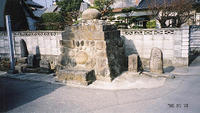
Look at the male symbol stone here too:
http://www.digi-ken.org/archives/dousojin/kuwado.html
And more are here:
http://kaboco.hp.infoseek.co.jp/photogarally/inyohphoto1.html
http://miyazaki.daa.jp/inyo/
http://www.city.kobayashi.miyazaki.jp/syoukoukankouka/inyoseki/inyouseki.html
http://dingodeg.hp.infoseek.co.jp/go/inyouseki.html
..... ..... .....
Doosojin can also be made of wood and be placed in a small wayside shrine, but not many old ones survive. 木祠型道祖神. A famous one of about one meter is in Sangakuchoo at the Kanazakura Shrine. 甲府市御岳町金桜神社. It is made from the root of a tree, covered with a copper roof.
..... ..... .....
Wayside Gods bound by a rope, hannawa doosojin 半縄道祖神
Here are two links:
http://www3.zero.ad.jp/futatsuya/home-page%20hananoujou/hannawaa.html
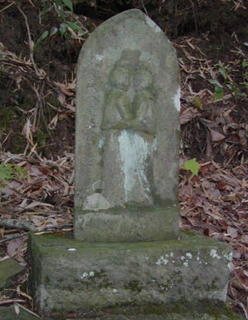
男女が抱擁する「歓喜天形」。安永8年(1779)
http://www3.zero.ad.jp/futatsuya/home-page%20hananoujou/hannawab.html
..... ..... .....
Very good English introduction to the subject
by Mark Schumacher, with many photo tours around Japan
Dosojin 道祖神 and the related explanations of
Kooshin and Monkeys.
.......................................................................
. 道祖神 Dosojin - Legends about the Wayside Gods .
from many parts of Japan !
:::::::::::::::::::::::::::::::::::::::::::::::::::::::::::::::::::::::::::::::::::::::::::::::::::::
Some famous places with many Doosojin in Japan
Doosojin Meguri 道祖神巡り
One area famous for its Wayside Gods is in Nagano Pref., Mochizuki-Choo along the road to Motai, where more than 140 can be found along the road to Motai.
望月宿・茂田井間: 野の仏は2000基以上、道祖神は140体を数える。原始時代からの原始信仰でなんでも願い事がかなう。
http://www.icon.pref.nagano.jp/usr/e-shinano/mochidukimachigide.htm
http://www.icon.pref.nagano.jp/usr/motizuki.com/honbun7.htm
http://www.icon.pref.nagano.jp/usr/shokoren-nagano/n-boast/motizuki/motizuki.html
..... ..... .....
Kurabuchi Gunma Pref. 倉渕村
美しい緑の山河に囲まれた安らぎのふるさと「倉渕村」は、ほほえましい愛の神、「道祖神」のふるさとでもあります。
倉渕村には、77ヵ所、113体の道祖神がありますが、その特色と言えば、・・・、その信仰の源流の多さと古さ、また、愛の神々の形式の多様さと双体像の姿の変化のユニークさ、一村としてはその数の多さ、更には、道祖神祭りに伴う民俗の多彩さにあり、一口で特色を述べることは難しいです。
しかし、享保(1716年)をピークに、その前後に造立された道祖神には、人間臭さが漂い始め、男神像の伸びた手が、女神像の胸や股間に触れていたり、寛保(1741年)から宝暦(1751年)にかけてのものには、ほほえましい姿のものがあります。 このように、双体道祖神が多いのは、本村の特色の一つかもしれません。
http://www.vill.kurabuchi.gunma.jp/dousojin/
With all of them here on three pages
http://www.vill.kurabuchi.gunma.jp/dousojin/ichiran/index.html
http://www12.wind.ne.jp/nisikarasu/kurabuchi/bunkazai/syasinsyuu.htm
..... ..... .....
Yamanashi, 1)山梨市七日市場
A natural stone of about 1 meter length and 110 cm diameter.
Dosojin Project
..... ..... .....
Niigata, Nagaoka Shi 新潟県長岡市
The one on the link is about 60 cm high. It represents the protective deity of the village.
太田洞門を出た道端にあり、高さは約60cm。
道祖神は本来、十字路や村境に立って悪霊を防ぎ、村人を守護する神でしたが、やがて旅人の安全を守る道の神にもなりました。
他の地方では、男女の像が彫られているように縁結びの神、夫婦和合の神として信仰しているところもあります。
http://www.city.nagaoka.niigata.jp/dpage/kouhou/sai/sai/48.htm
..... ..... .....
Azumino 安曇野, Nagano, on the border to Gifu Pref.
In the Northern Alps of Japan, close to the Hotaka Mountains.
Azumino is a mecca for Dosojin statues.

CLICK for more photos !
..................................
. The Azumi clan 安曇族 Hakata -
- Azumi no Isora Maru 阿曇磯良丸 .
.......................................................................
Wayside Deities Statues from the Genroku Period
高根カミの元禄8年双体像
高根の路傍に、美しい姿の双体道祖神があります。惜しいことに頭が少し欠けていますが、頭を丸め、手を合わせて、柔和な表情を浮かべています。お地蔵さんのような姿で二体が並んで立っています。二体とも同じ様な格好なので、どちらが男か女か判別できません。
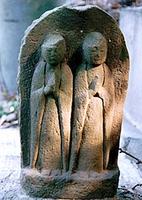
http://www.city.hiratsuka.kanagawa.jp/zukan/sanpo/sanp0205.htm
..... ..... .....
Stone Statues from Tsuchiya
A great page of photos.
土屋石仏道祖神
..... ..... .....
~ 伊那谷の道祖神 ~ Statues from Inadani
http://park11.wakwak.com/~kuwa/dosojin.htm
:::::::::::::::::::::::::::::::::::::::::::::::::::::::::::::::::::::::::::::::::::::::::::::::::::::::::::::::::::::::::::
岐戸大神 / 岐戸の神 / 岐ノ尊 kido okami, Kido no Kami
a deity to show the way
岐戸大神は道案内の神
Funado no Kami , Kunado no Kami 岐の神(ふなどのかみ、くなどのかみ)
Chimata no Kami 巷の神(ちまたのかみ)または
Tsuji no Kami 辻の神(つじのかみ)"crossroad deity

- source : 都辨志呂神社
- quote -
Funado / [Funado no kami](Nihongi)
Other names: Kunado sae no kami (Nihongi),
Tsukitatsu Funado no kami (Kojiki)
The first of the kami produced by Izanagi as he threw down his staff in preparation for ablutions at "Awakihara by the Strait of Tachibana in Hyūga of Tsukushi" following his visit to the underworld (Yomi).
According to an "alternate writing" transmitted by Nihongi, Izanagi blocked the road at the "even pass of Yomi" with a rock that would require 1,000 men to pull. Ordering Izanami not to come beyond that point, he flung down his staff, which became the kami Funado. Another alternate version transmitted by Nihongi relates that Funado was produced when Izanagi cast down his staff to the thunders, telling them, "Do not come beyond this." This alternate also notes that the original name of Funado was Kunadosae no kami (kunado means "come not" and sae means "border"), a name describing a border tutelary believed to prevent the ingress of evil.
In short, Funado is dōsojin. This role as kami of roads and borders is reflected in still another "alternate writing" in Nihongi, which states that "Futsunushi no kami made Kunado no kami his guide."
Likewise, the norito litany Michiae no matsuri (Feast of the Roads) found in Engishiki includes the name of the kami Kunado as well as Yachimatahiko and Yachimatahime (kami of the "eight byways").
- source : Nishioka Kazuhiko - Kokugakuin 2005
:::::::::::::::::::::::::::::::::::::::::::::::::::::::::::::::::::::::::::::::::::::::::::::::::::::::::::::::::::::::::::
Doosojin Festivals 道祖神祭り
Nozawa Doosojin Himatsuri
15 January , Nozawa Onsen, Nagano Prefecture
The Dôsojin Fire Festival is one of the three most famous fire festivals in Japan. It is held on January 15th every year to pray for a plentiful harvest, health and good fortune in the coming year. The festival dates back to 1863 and though the location has changed, the festivities remain the same.
During this festival the twenty-five and forty-two year old men from the village play a very important role. An old belief in Japan dictates that, for men, these years are unlucky ages. The twenty-five and the forty-two year old men in their unlucky ages construct the shaden (shrine) from beech wood that reaches a height of 18 meters.
Every year it takes 100 villagers to build the shrine. The trees are cut down in October and brought down from the mountain, through the village, on January 13th. After the shaden has been constructed, the priest from Kosuge shrine performs a ceremony to endow it with a God.
Along with the shaden there are an average of five tôrô (tooroo, dedicatory lantern poles) erected every year. These poles are made by a family in the village to celebrate the birth of the first son. The tôrô are offered to the Gods in a prayer for health and good fortune. The festivities begin with the lighting of the fire by the twenty-five and fourty-two year old men.
A small group of men carry a torch, which is lit by striking two stones together, from the Kôno residence to the festival grounds. The torch is used to start a bonfire from which the handmade torches, used to attack the shrine, are lit. The festival centers around the shaden, where the fourty-two year olds sit on top and the twenty-five year olds stand guard at the base.
Those who are 41 and 43 years old stand around the perimeter to protect the spectators. Torch bearing villagers of all ages attempt to break through the guards and light the shaden on fire. A dangerous and lively battle ensues. The defenders try to put out the fire by striking it with pine branches. The attack lasts for about one hour, after which the 42 year olds call an end to the ceremony and the shaden together with the tôrô are set on fire in an offering to the Gods. The entire festival can take up to four hours from the beginning to the end, but the main attraction is the battle between the guards and the torch bearing villagers.
Look at the accopmanying photos here:
http://www.vill.nozawaonsen.nagano.jp/info/english/dosojin.htm
... ... ...
With a Daruma photo
1月15日
篠ノ井塩崎越 公民館の庭
http://www.azumino.cnet.ne.jp/meditation/nagano/indexn-6.html
Dondoyaki, good photos
道祖神2へ 道祖神3へ
http://maru4834.hp.infoseek.co.jp/dondoyaki/dondoyaki1.htm
小正月の1月14日、市内下小野で道祖神の飾り(塞の神)が立てられました。
http://www.bremen.or.jp/mnews/dousojin99.htm
... ... ...
Page with many picutres, Text in Japanese.
http://www.dynax.co.jp/sinsen/gallery/nozawa/himatsuri/
http://www.dynax.co.jp/sinsen/gallery/nozawa/himatsuri/i_hatsutourou.html
Finally burning
http://www.dynax.co.jp/sinsen/gallery/nozawa/himatsuri/i_moeagaru.html
Another link with many pictures:
http://www.nhk.or.jp/nagano/wink/eizo100/wink82eizo100.html
http://www.soccerphile.com/japanvisitor/jc/jan_fest.html
Great picture of the burning of bad luck.
http://www.localinfo.nagano-idc.com/kanko/himaturi/image/himaturi.jpg
http://www.localinfo.nagano-idc.com/kanko/himaturi/
One more fire picture
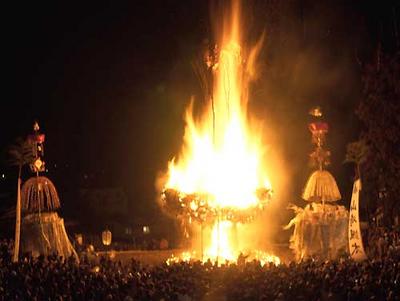
http://www.shinmai.co.jp/kanko/saijiki/00002.html
... ... ...
Fire Ceremonies at other times, not the New Year Season
9月28日 道祖神祭り(長野・美ヶ原温泉)
Doosojin Festival at Migahara Onsen, Nagano
http://www.sugikoto.com/dousosinfs.htm
Tagata Jinja
The Tagata-hohnen matsuri is held at March, 15th every year.
It's the festival praying for a rich harvest. It's famous for a sexual event. We thought that a Dengaku matsuri mixed with a Dosojin matsuri, ( "Dengaku matsuri" is originally the festival at sowing, and then it came to the one of shrines and temples.
"Dosojin" is the God of laying a road's ghost and guarding travellers. ) It's characterized by the portable shrine with the penis model.
http://www.jah.ne.jp/~rshingen/eng/cbat02.htm
WKD . Honen Matsuri (Hoonen Matsuri 豊年祭)
Tagata Shrine
Kanayama Shrine 金山神社
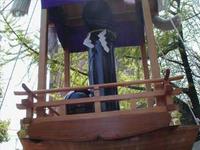
This shrine in Kawasaki is especially popular with foreigners. During the annual Phallus Festival (Kanamara Matsuri) in the first week of April many replicas can be seen.
http://www.kt.rim.or.jp/~sokohaka/chin-man/kanamara_m.html
http://tomuraya.co.jp/wakamiya-10.html
..... Link in English
http://www2.biglobe.ne.jp/~zmy/data/e_kanam.htm
. . . CLICK here for Photos !
:::::::::::::::::::::::::::::::::::::::::::::::::::::::::::::::::::::::::::::::::::::::::::::::::::::
kigo for ealy winter
Tennooji doosojin matsuri 天王寺道祖神祭
Dosojin Festival at temple Tenno-Ji
hagi matsuri 剥祭(はぎまつり)"left-out festival"
dorojijiri matsuri 泥くじり祭(どろくじりまつり)
On November 16 at the temple Tenno-Ji in Osaka.
Also at the temple Shinkooin 真光院(しんこういん)Shinko-In.
During the Edo period, stone Buddha statues were offered raw herring and the face smeared with white rice flour. Mikan wrapped in sasa grass leaves and straw were also offered.
In the evening the straw and grass was burned until the face of the deity was all black and people danced around the stone.
Three days before this event, children hang a rope over the way and ask for money if people want to pass. If they do not pay, they are "left out".
This festival was said to have an evil influence on the education of children and was later abolished.
Most temples in other parts of Japan celebrate this festival on January 14 or February 8.
Shitennō-ji (四天王寺) is a Buddhist temple in Osaka, Japan.
© More in the WIKIPEDIA !
:::::::::::::::::::::::::::::::::::::::::::::::::::::::::::::::::::::::::::::::::::::::::::::::::::::
Clay Bells with Doosojin 道祖神の土鈴
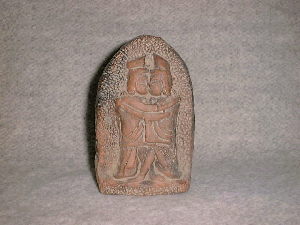
A great collection of more than 12
http://www2.ocn.ne.jp/~kobanawa/dorei.htm
The back side is like a sexual organ
群馬県、水沢観音の道祖神土鈴伊香保温泉に行く途中に寄った水沢観音で売っていた道祖神の土鈴。包み紙は、なぜか榛名湖畔の「湖畔亭」となっている。群馬県、水沢観音の道祖神土鈴
http://cardiac.exblog.jp/i4
There is also a Daruma dorei on this blog!!
Great link about the origin of DOREI, not so much on Doosojin
Ta no Kami
田の神とは、日本書記によると神代の頃より農神をまつり諸行事が行われたごとく書いてある。土俗信仰の為め、地蔵型の神を建立し、天災や稲虫の被害を免れる農作所としたわけである。 神象の背後を拝む女性があったのは、笠冠型の背後から見ると、男性のシンボルそのままの形をしているものが多く、女性はそのシンボルに向かって、一心に子授けの祈願をかけたのであり、表面は田の神、裏面は道祖神背中合わせではあるが、稲作か、子孫繁栄の増産の神か一体二神の象である。
Doosojin
塞の神、幸の神、歳の神とも云われ、道路の辻、村境、峠などに奉祀され邪悪なものをさえぎる神とされて来た。この地方では男女二神が手を取り合ったり、肩に手を掛け合ったり、和 合の形を示したものが非常に多い。境界をかためるのに、この男女円満の姿を示すことは邪 悪者をしりごみさせるので有効だと考えられてきた。 このことがさらに縁結びの神とか性の神のように見られてきた。この素朴な土鈴の音色から男女の愛のささやきを、ききとりたいものである。
(信州日本民芸社 信州庶民館)
http://www.eonet.ne.jp/~i-kimoto/hurusato/yuraisyo.htm
One photo from an Ooyama Clay Bell
[大山土鈴・道祖神土鈴]
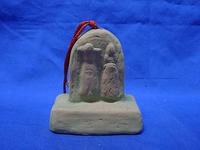
http://www.h2.dion.ne.jp/~whcc/79.html
. Ta no Kami 田の神 God of the Rice Fields .
and Yama no Kami 山の神 God of the Mountain
:::::::::::::::::::::::::::::::::::::::::::::::::::::::::::::::::::::::::::::::::::::::::::::::::::::
O-Mamori Talisman with Doosojin
お守りに道祖神
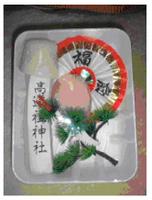
From Takasai Shrine, 高道祖神社 Ibaragi Pref. With a male and female sex organ symbol.
http://chuchu.lolipop.jp/jinjya-ibaraki.htm
太古、北九州に栄えた海洋民族で、7世紀頃安曇野(あずみの)に移住し開拓したと伝えられる、安曇族の祖神(おやがみ)、穂高見命(ほたかみのみこと)を祀る神社。境内には、穂高見命の化身である泉小太郎の像があるが、南方系のサイに乗るというユニークなもの。手を取り合った男女の神様(双体道祖神)が描かれた「道祖神お守り」500円は、安曇野らしい人気の授与品。交通安全に御利益が大だとか。
安曇野を拓いた安曇族を祀る神社
穂高神社 (ホタカジンジャ) Hotaka Shrine
http://kanko.travel.rakuten.co.jp/kanko/go/resource$id=SHNN050020
:::::::::::::::::::::::::::::::::::::::::::::::::::::::::::::::::::::::::::::::::::::::::::::::::::::
Doosojin Kooen Park 道祖神公園
Nagano Pref. Hotaka Village.

〒 399-8303 長野県南安曇郡穂高町穂高
昭和50年に放送されたNHKの連続テレビ小説『水色の時』。松本を舞台に、医大進学を目指す知子(大竹しのぶ)と母・房子(香川京子)の交流を描いたドラマで、そのロケに使われたのが、道祖神公園の双体道祖神。男女ふたつの神様が並んで彫られた双体道祖神は、穂高町に80体以上ある。ドラマのために造られた道祖神公園は、有明山、燕岳を借景にし、記念写真にもいちばんの絶景!
http://kanko.travel.rakuten.co.jp/resource/SHNN050021/
. . . CLICK here for Photos !
:::::::::::::::::::::::::::::::::::::::::::::::::::::::::::::::::::::::::::::::::::::::::::::::::::::
More Japanese Links to the Wayside Gods
http://www.pref.gunma.jp/a/gyousei/nak/soumukeizaibu/dousojin.html
http://www.pandaemonium.net/menu/devil/douso.html
http://blog.goo.ne.jp/beansoikos/e/f499f5bcc61fcddb96bec02f5b2b82ec
http://www.u-arc.co.jp/dousojin.htm
http://www.city.fuji.shizuoka.jp/cityhall/kyoiku-b/hakubutukan/a6-1/a6-1-3-15.html
Jooshu Province
http://www.d3.dion.ne.jp/~arot/Film-24/03.jpg
http://www.d3.dion.ne.jp/~arot/Film-24/09.jpg
See more here:
http://www.d3.dion.ne.jp/~arot/Mind-6.htm
The Doosojin Project (in Japanese)
1)山梨市七日市場 Yamanashi Town
2)山梨市下井尻西上組 Yamanashi Town
3)塩山市上井尻能麦(のんばく) Enzan Town
4)東山梨郡春日居町桑戸 Kasugai Cho
5)甲府市横根町 Koofu Town
http://www.digi-ken.org/archives/dousojin/doso.html
路傍の道祖神や石仏について
石仏フォトギャラリー Photo Gallery
都筑の丘の道祖神めぐり
遍路道の道標と石仏(13) Pilgrims in Shikoku
関東甲信越の道祖神たち Around Tokyo
東京都町田市の道祖神たち Doosojin in Tokyo
:::::::::::::::::::::::::::::::::::::::::::::::::::::::::::::::::::::::::::::::::::::::::::::::::::::
Books about Doosojin
道祖神信仰史の研究 Study about Wayside Deities
石田哲弥 著
http://www.meicho.co.jp/new/
道祖神文献
【参考文献】
・『諏訪大社』 三輪磐根 (學生出版)
・『御柱際と諏訪大社』 上田/大林/五来/宮坂光明/宮坂宥勝 (筑摩書房)
・『石神信仰』 大護八郎 (木耳社)
・『全国石仏石神大辞典』 中山慧照 (リッチマインド出版事業部)
・『菅江真澄全集 第一巻 すわのうみ、より』 内田武志/宮本常一編 (未來社)
・『日本書紀』 坂本/家永/井上/大野校注 (岩波書店)
・『古事記』 武田祐吉訳注 中村啓信補訂解説 (角川書店)
・『今昔物語集』 佐藤謙三校注 (角川文庫)
・『宇治拾遺物語』 中島悦次校注 (角川文庫)
・『御伽草子』 市古貞次校注 (岩波書店)
・『日本伝説集』 武田静澄 (現代教養文庫)
・『日本伝説集』 高木敏雄 山田野理夫編 (宝文館出版)
・『昔話・伝説必携』 野村純一編 (学燈社)
・『全国妖怪事典』 千葉 幹夫編 (小学館)
・『日本妖怪異聞録』 小松和彦 (小学館)
・『日本宗教の全て』 瓜生中/渋谷申博 (日本文芸社)
http://www.pandaemonium.net/menu/devil/douso.html
:::::::::::::::::::::::::::::::::::::::::::::::::::::::::::::::::::::::::::::::::::::::::::::::::::::
Sankuroo and Daruma 三九郎とだるま
This is most famous in Matsumoto, where three large stakes of pine wood are piled up and the decorations for the New Year are burned. Many Daruma Papermachee Dolls also are hung on these piles and burned. Some look almost like Christmas trees with large red bells.
Sankuro in Shinano三九郎(さんくろう)
子供の行事。
どんど焼きともいう。
まず、1月7日にお正月の門松を集める。これを「外松集め」と言う。
その後、1月15日に(祝日改正のおかげで、日程が定まらずに困っている)家の中の飾りや、だるまを集める。これを「内松集め」と言う。
集めた物は田んぼやかわらにピラミッド型に積み上げ、15日の夕方に焼く。
火がつけられる前に前に、子供たちは町中をまわり♪「三九郎、三九郎。爺さと婆さと孫連れて、団子焼きに来ておくれ」と唄う。
焼く時には柳の木の枝にだんご(野菜の形にしたり、繭玉の形にしたり)を刺したものを持って行き、焼いた物を食べると1年間、風邪をひかないと言われている。
また、書き初めを燃やすと、字が上手くなるとも言われている。
http://www.shiojiri.ne.jp/~hideko/jiten22.htm
:::::::::::::::::::::::::::::::::::::::::::::::::::::::::::::::::::::::::::::::::::::::::::::::::::::
... ... ... Haiku and Doosojin
observance kigo for the New Year
Doosojin matsuri 道祖神祭 (どうそじんまつり)
Dosojin Festival
Sai no kami matsuri 塞の神祭(さいのかみまつり)
..... 幸の神祭(さいのかみまつり)Sai no Kami festival
Doorokujin matsuri 道禄神祭(どうろくじんまつり)

They are usually held on January 15, the "small new year" (koshoogatsu 小正月).
They relate to the Sagicho festivals and are more popular in Northern Japan.
. WKD : New Year Ceremonies .
.................................................................................
Even in the famous “Narrow Road to the North”, Matsuo Basho writes about the stone wayside gods.
Quote:
Basho speaks paradoxically about how the gods have motivated his decision to travel. He refers to two types of gods. The first is Sozorogami. There is some uncertainty about this word which appears to be one Basho invented for appears nowhere else in Japanese literature. It seems to indicate a deity who bewitches one to aimless travel, a god who causes him to feel restless. On the other hand are the Dosojin, deities who protect travellers. Dosojin are customarily placed at the entrances to villages, at mountain passes, crossroads, or bridges to prevent evil influences or evil spirits from passing. They also guard the boundary between the land of the living and the land of the dead. Thus he presents one deity (Sozorogami) who infects people with the urge to travel despite the dangers involved, and another (Dosojin) who protects people who do travel.
http://darkwing.uoregon.edu/~kohl/basho/1-prologue/discussion.html
And at Kasashima
(1) Kasashima
We entered the province of Kasasima after passing by the Abumizuri and Shiroishi castles. We made inquiries concerning the whereabouts of the tomb of To-no-chujo Sanekata (General Sanekata of Fujiwara) and were told that the two hamlets off to the right seen in the distance near the hills were called Minowa and Kasasima. A shrine to Dosojin was located there, at which susuki (eulalia) grass could still be seen. I said “Unfortunately, the spring rains had made the roads all but impassable.
Read a great exposition about wandering priests
Fura-Bo(Wandering-priest): The Narrow Road to Tradition
A Japanese Link
奥の細道: ─道祖神の旅
http://www.h6.dion.ne.jp/~yukineko/okunohosomiti.html
Kigo in this connection
Sagichoo, dondoyaki…
http://www.nichibun.ac.jp/graphicversion/dbase/kigo/data/01/01130247.html
a loving couple
during all seasons
spring in the air
Gabi Greve
Haiku and Happiness : Stone Buddhas
. michikiri, michi-kiri 道切 / 道切り "Cutting off the Road" .
to prevent evil spirits and monsters from entering and drive them away.
sakaigami 境神 "boundary deities"
:::::::::::::::::::::::::::::::::::::::::::::::::::::::::::::::::::::::::::::::::::::::::::::::::::::
. sojin, soshin, oyagami 祖神 spirits of ancestral deities .
. Ta no Kami 田の神 God of the Rice Fields .
Yama no Kami 山の神, God of the Mountain
. Tsujidoo 辻堂 roadside sanctuary
nobotoke 野仏, tsujibotoke 辻仏
. kideko, ki deko 木でこ head made from wood
Ootomo ningyoo 大友人形 Otomo dolls .
wayside dolls from Beppu, Oita
:::::::::::::::::::::::::::::::::::::::::::::::::::::::::::::::::::::::::::::::::::::::::::::::::::::
***** . warauma hiki, wara-uma hiki 藁馬曳き
leading a straw horse
at Tozawa, Nagano, during a Dosojin Festival
kigo for early spring
:::::::::::::::::::::::::::::::::::::::::::::::::::::::::::::::::::::::::::::::::::::::::::::::::::::::::::::::::::::::::::
道陸神社 Dosojin Jinja
3758 Kotsumi, Kaizuka, Osaka Prefecture
a Shinto Shrine with Daruma


:::::::::::::::::::::::::::::::::::::::::::::::::::::::::::::::::::::::::::::::::::::::::::::::::::::::::::::::::::::::::::
[ . BACK to WORLDKIGO . TOP . ]
[ . BACK to DARUMA MUSEUM TOP . ]
- #dosojin #dososhin #tanokami #sainokami -
:::::::::::::::::::::::::::::::::::::::::::::::::::::::::::::::::::::::::::::::::::::::::::::::::::::







19 comments:
New Year's bonfire
and a New Year's snow
coming down
ISSA
Look at the Haiga to go with it*
. everyday Issa by
Nakamura Sakuo .
::::::::::::::::::::::::::::::::::::::::::::::::::::::::::::::::::::::
道祖神に取り付かれないようにしていたのにとうとう、摑まりました。
この原始信仰は力強くてとても面白いですね。
一茶がらみで、勉強してみますか?
sakuo
. Ta no Kami, God of the Fields .
and its connection to Haiku.
::::::::::::::::::::::::::::::::::::::::::::::::::::::::::::::::::::::
冬山の石仏群の崩壊す
fuyuyama no ishibotokegun no hoo kowasu
the landslides
near the group of stone buddhas
in the winter mountains
Takano Sujuu
天王寺道祖神祭 てんのうじどうそじんまつり
Wayside God Festival at Temple Tenno-Ji, Osaka
剥祭(はぎまつり)
泥くじり祭(どろくじりまつり)
dorojiri matsuri "butt in the mud" festival
kigo for mid-winter
Toono chuujoo Sanekata 藤中将実方 Tono Chujo Sanekata
Fujiwara no Sanekata 藤原実方
(? - 998)
A waka poet of the Heian period, during the reign of the Emperor Ichijo (986-1011).
He has one poem in the collection "100 poems from 100 poets".
Legend knows that he was quite a quarreler, and after an argument in the palace with Fujiwara Yukinari he was ordered in exile, as Governor of Mutsu province 陸奥の国.
One day he passed a small shrine of the wayside deities Dosojin 道祖神 of Kasajima without getting off his horse. As divine punishment he was thrown from his horse and died.
Ogura Hyakunin Isshu Poems 小倉百人一首
.
Matuo Basho visiting Kasajima (#Kasashima)
.
Kobayashi Issa
mushi naku ya doorokujin no o-tsumuri ni
insect crying
on the stone head
of a love god
Comment by Chris Drake :
夫婦河童の道祖神 Kappa Couple as Wayside Gods
- KAPPA - 河童 / 合羽 / かっぱ / カッパ - ABC-Index -
.
http://kappapedia.blogspot.jp/2014/12/female-kappa.html
Akita 秋田県 山本郡 Yamamoto gun 二ツ井町 Futatsui machi
Kogake hamlet 小掛
At the entrance to the hamlet Kogake there is a special kind of human-like dososhin wayside deity 人形道祖神 to protect the village, called
Shokisama 鍾馗様 Shokisama
In fact there is a pair, man and woman.
These statues protected the village from evil spirits, epidemics and other diseases and are well visited even today.
In the nearby hamlet of Tsurugata 鶴形 there is a similar pair of these human-like statues.
They are made from wood painted red (to prevent diseases) and have long hair. They both have a piece that looks like a long pipe (kiseru 煙管).
Near the waist they have two swords and a bento lunch box 弁当箱.
(By the way, in Yokote there are some statues of this kind with a lunch box containing Natto fermented beans 納豆.)
.
http://darumamuseum.blogspot.jp/2007/05/shoki-and-daruma.html
.
Ibaraki, Ibaragi 茨城県
江戸崎町 Edosaki machi
Yashinboo Doosojin やしんぼ道祖神 Yashinbo Dosojin, "Malicious Dosojin"
yashinbo卑しん坊 means someone who wants anything around him.
Near the shrine 鹿島神社 Kashima Jinja there are three small stone sanctuaries for these wayside gods.
They offer their help and grant a wish if you bring some o-sake whilst making a wish.
On the other hand, if you take away just one stem of the wild sasa bamboo around, they will get angry and bring harm.
Most farmers who come to worship here bring offerings and clean the place carefully.
.
http://japanshrinestemples.blogspot.jp/2015/04/sake-yokai-legends.html
.
Dooso Jinja 道祖神社 Doso Jinja
"Shrine for the Wayside Deities (Dosojin)
Kyoto
都市下京区油小路通塩小路下る南不動堂町
Aburanokoji, Minami Fudodo-Cho
.
http://fudosama.blogspot.jp/2015/07/fudo-do-cho-kyoto.html
.
Ichigami 市神 / いちがみ deity of the market town
http://japanshrinestemples.blogspot.jp/2016/05/ichigami-deity-of-market-town.html
.
hidarugami ヒダル神
40 legends to explore
.
- Hidarugami ヒダル神 The Hunger Gods -
In Tosa, when making a 弁当 Bento food offering for Yamanokami or Hidarugami, there are always a pair of chopsticks added.
This will prevent Hidarumami to take possession of a person. If one fears to have been possessed, one has to throw some part of the clothing behind oneself.
.
https://japanshrinestemples.blogspot.com/2017/08/yama-no-kami-regional-16-kochi.html
.
Legend from Shiga 滋賀県
高島郡 Takashima district 今津町 Imazu town
Yamanokami is a 天狗 Tengu and lives in the trees.
At the bottom of the mountain sacred to Yamanokami are statues of 道祖神 Dosojin, to pray for safety of the traveler.
.
https://japanshrinestemples.blogspot.com/2019/02/yamanokami-regional-26-saga-saitama.html
.
Legends about hidarugami ひだる神
from Kobe Mount 六甲 Mount Rokkosan
.
https://edoflourishing.blogspot.com/2019/09/tokugawa-michi-road.html
.
Sai no Kami 幸神 / さいの神 Deity of Fortune and Good Luck
https://japanshrinestemples.blogspot.com/2020/01/sai-no-kami-legends.html
.
Hidarugami ヒダル神 / ひだる神 / ヒダルカミ
Legends about the Hunger Gods
Hidarigami ヒダリガミ
.
https://japanshrinestemples.blogspot.com/2019/07/hidarugami-hidarubo-legends.html
.
kayougami 通う神 / 通神
anothere name for the Dosojin.
.
Legends
https://edoflourishing.blogspot.com/2014/01/senryu-yoshiwara.html
.
Post a Comment